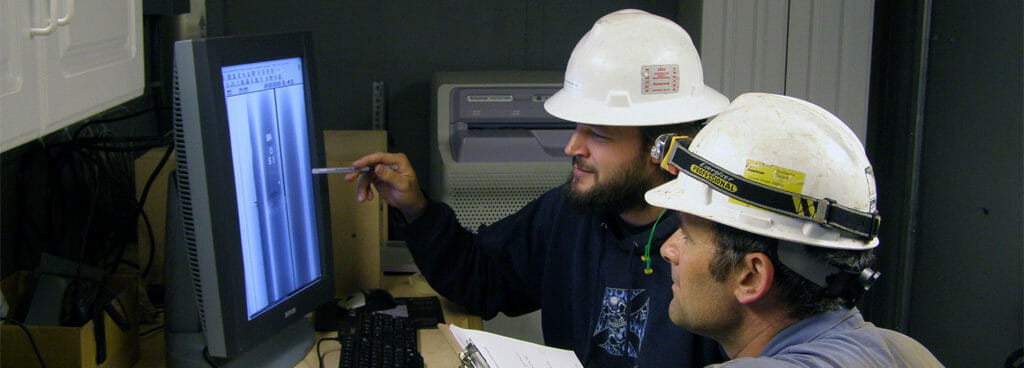- Home
- Special Services
MARINE SERVICES
construction
other services
weld services
- NDT Services
methods
additional services
- About Us
- Locations

REASONS FOR REQUESTING A CONCRETE INSPECTION
International Inspection stands out from other concrete X-ray companies because of the comprehensive nature of our testing services. Clients working in the construction and commercial property industries take precautions to ensure their job proceeds as planned. Projects such as tenant improvements, seismic upgrades, and new construction may require working on concrete. If that project includes drilling, coring, or cutting, nothing can derail it quite as quickly as hitting something unexpected (such as PT cable or rebar) buried beneath a slab’s surface. Doing so can cause a variety of bad things to happen, including:
- Severed utility lines: requires pausing work, costly repairs
- Damaged equipment: expensive repair/replace decisions, stops work, creates a hazardous working condition
- Injured workers: lawsuit liability, loss of workforce, potential casualty
Companies grasp the need to avoid each of the above pitfalls, and so request professionals to perform an inspection on the concrete they intend to work. Concrete X-ray companies — notably, International Inspection — perform these services to ensure clients can continue their work safely and efficiently.
How the Process Works
Our field technicians look for subsurface features on concrete walls, suspended slabs, and concrete masonry units (CMUs) using radiography. The specific technique we employ uses gamma rays to create an image of the subject’s interior conditions. To achieve this effect, the concrete inspection team aims a projector at the slab. This device produces gamma radiation in a cone shape by exposing a source called Iridium-192. The projector focuses and directs this energy using a collimator, which causes it to travel through the subject on its way to a detector mounted across from it. Finally, the detector captures the amount of energy it receives as data, which our experienced technicians will develop on film in our mobile darkroom; this yields a radiograph, an image that shows everything beneath the surface of the subject.
The resulting image’s black-and-white characteristic tells researchers certain things about the slab’s subsurface features. Different materials block different amounts of energy as the X-Rays pass through them, with materials of lower density (such as air) blocking less and materials of higher density (such as steel) blocking more. Correspondingly, the detector processes the difference in the amount of energy it receives and displays these disparities as darker areas for less dense materials and lighter for very dense materials that the X-Rays could not penetrate.
This quality, along with the high-resolution images we can achieve with our powerful equipment, give our concrete inspection team the most detailed understanding of what is under the surface of a given slab. These experts then lay out their findings on the surface of the slab — color-coded and easy for workers to understand at a glance.
Most Common Findings
- PT Cables
- Rebar
- Electrical Conduit
- Utility Lines
Why Choose International Inspection Over Other Concrete X-ray Companies
We have been providing dependable concrete inspection services for over 20 years now. Not only are the members of our concrete inspection team each certified in accordance with SNT-TC-1A as Level II and Level III technicians qualified to safely perform radiography services — but we also maintain a license with the State Radiological Health Department to perform the method and retain a state-approved radiation safety officer on our staff. These experts take concrete X-Ray jobs 24/7 and offer a versatile range of services to ensure that they can meet a spectrum of client needs.
Furthermore, International Inspection maintains an exceptional record of radiation safety — a distinction we take great pride in. Our company has performed perfectly on every State and Federal audit of our radiation safety program. This excellence stems from our management team’s dedication to radiation safety. Our inspection teams closely adhere to corporate radiation safety procedures in the field to ensure the safety of the general public.
An Alternative to X-ray: Concrete Scanning
Our field team also employ another method to check to make sure no surprises are hiding in a slab of concrete, depending on the circumstances on the jobsite. The technique, referred to as ground penetrating radar (GPR) or subsurface interface radar (SIR) depending on the manufacturer of the assessment tool, allows technicians to determine the location of ferrous elements beneath the surface.
This method uses less powerful radio waves to generate an image that helps them detect the location of PT cables, rebar, and the like. The scans yielded by this method are not as straight-forward as the radiographs produced by X-Rays, and so must be interpreted by an experienced concrete scanning technician like those we employ. Each technique offers certain strengths and limitations that are, thankfully, balanced out by the other method. Providing both the predominant methods of concrete analysis allows International Inspection to offer the most efficient and cost-effective solution to our clients.
Customers who do not know which technique to choose or combination to request can contact us with details on the scope of their project; we will help them figure out the best way to proceed with their concrete inspection. If your company needs concrete X-Ray services, contact International Inspection today! Our credentials and expertise in performing radiography for this application set us apart from other concrete X-Ray companies.
